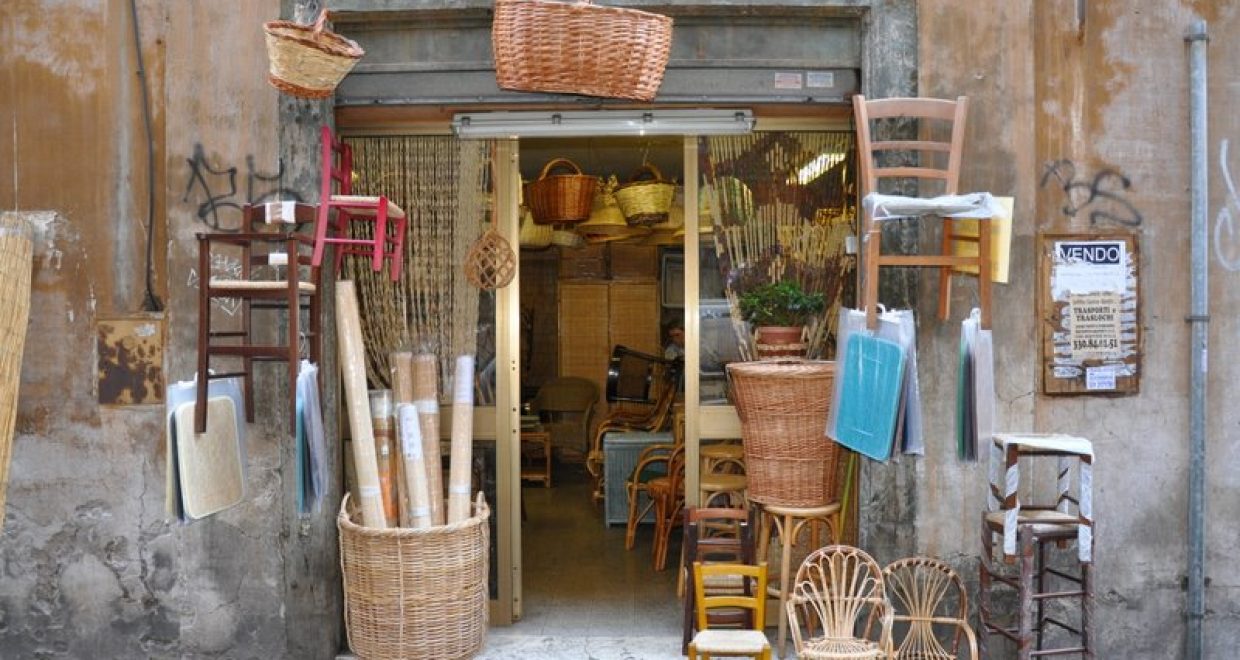Shopping in Rome from ancient to modern
Claire Holleran, University of Exeter, discusses her forthcoming article, ‘Finding commerce: the taberna and the identification of Roman commercial space’ in Papers of the British School at Rome (2017), which will shortly be published via FirstView on Cambridge Core.
Wandering around Rome during a stay at the British School researching a book on Roman retail, I was struck by the apparent similarity between the small shops and workshops on some of the back streets and the picture of ancient retail that was emerging from my work. The wicker workshops along the Via dei Sediari, for example, with finished baskets and chairs hanging from the architrave and set out on the street for sale, brought to mind Martial’s complaint about tabernae in Rome commonly spilling out over their thresholds. Architecturally too, these small units were almost identical in form to the rooms that I was seeing lining the main streets at Roman sites such as Pompeii and Ostia. Such rooms are typically referred to in modern scholarship using the Latin term taberna, and are identified by wide entranceways and grooved thresholds, which were designed to hold wooden shutters when closed. And yet drawing such analogies between the ancient and the modern world can lead to misunderstandings and anachronistic assumptions, making it appear as though very little has changed in millennia. With this in mind, I set out to establish what Roman commercial space might actually have looked like, how we might identify it in the archaeological record, and how it might be used. Were the rooms lining the main streets of Pompeii and Ostia really so similar to those in the back streets of modern Rome? How might we identify their function? Were rooms of this type really what Martial was thinking of when he talked about tabernae? Where else might commercial activity have taken place?


Responding to these questions, this article takes the taberna as a starting point. It demonstrates that we are broadly correct in drawing a relationship between the literary taberna of Martial and others, and the physical spaces to which this term is widely applied. Livy’s description of Camillus entering Tusculum, for example, and seeing all the tabernae open, displaying the goods and activities within to passers-by is a scene that is easily envisaged when standing in the Via dell’Abbondanza at Pompeii. Drawing on ancient literary examples of the taberna can, therefore, tell us something about the function of these units, indicating that they could be used for a wide variety of commercial purposes, ranging from shops, workshops, and bars, to offices, doctors’ surgeries, and barbers’ shops, as well as serving as residences, primarily for those working within. Nevertheless, we must be careful not to privilege the literary evidence over the archaeological, and the material evidence should take centre stage when interpreting the use of a particular space in the archaeological record. By and large, however, this article demonstrates that the vast majority of excavated tabernae offer little archaeological evidence as to their original function, meaning that we must keep an open mind about how many of these spaces were actually used by their ancient occupants.
Furthermore, focusing on the taberna alone gives us only a partial picture of Roman commercial space. In richly-preserved contexts such as Pompeii, for instance, small finds indicate that commercial activities, such as metalworking, gem engraving, and cloth production on a relatively large scale, were taking place within apparently domestic spaces. Retail sales also took place within houses, particularly those of the wealthy. Indeed, the sexual threat of the pedlar who visited well-to-do women at home alone became a cliché in Latin literature. Streets, arcades, porticoes, and busy central spaces such as fora, temples, and entertainment venues were also popular locations for retailers, who sold their goods from temporary stalls, baskets, trays, and mats. Such practices will have left little trace in the archaeological record, but are clearly demonstrated by the literary, visual, and epigraphic material. By taking account of the full range of ancient evidence, it becomes clear that commercial activity stretched a long way beyond the taberna, and that analogies drawn from wanderings in the backstreets of modern Rome can only take us so far in our understanding of the Roman commercial landscape.
Sign up for content alerts to know when Claire’s paper is online.






